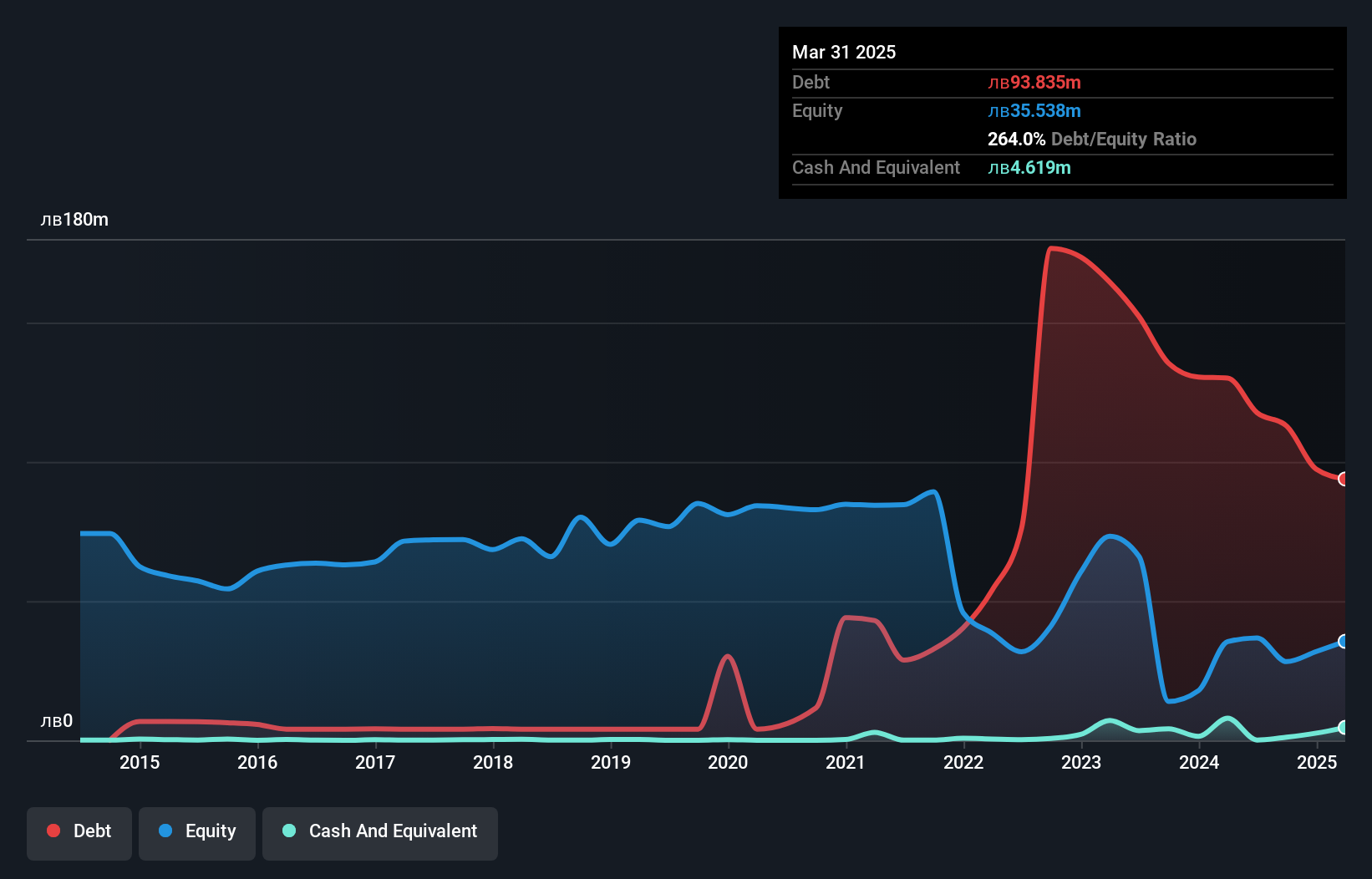Warren Buffett famously said, 'Volatility is far from synonymous with risk.' So it seems the smart money knows that debt - which is usually involved in bankruptcies - is a very important factor, when you assess how risky a company is. Importantly, Toplofikatsia-Ruse AD (BUL:TPLR) does carry debt. But the more important question is: how much risk is that debt creating?
When Is Debt A Problem?
Debt is a tool to help businesses grow, but if a business is incapable of paying off its lenders, then it exists at their mercy. In the worst case scenario, a company can go bankrupt if it cannot pay its creditors. However, a more usual (but still expensive) situation is where a company must dilute shareholders at a cheap share price simply to get debt under control. By replacing dilution, though, debt can be an extremely good tool for businesses that need capital to invest in growth at high rates of return. The first step when considering a company's debt levels is to consider its cash and debt together.
How Much Debt Does Toplofikatsia-Ruse AD Carry?
You can click the graphic below for the historical numbers, but it shows that Toplofikatsia-Ruse AD had лв93.8m of debt in March 2025, down from лв130.1m, one year before. However, because it has a cash reserve of лв4.62m, its net debt is less, at about лв89.2m.

How Healthy Is Toplofikatsia-Ruse AD's Balance Sheet?
The latest balance sheet data shows that Toplofikatsia-Ruse AD had liabilities of лв186.2m due within a year, and liabilities of лв170.8m falling due after that. Offsetting this, it had лв4.62m in cash and лв77.9m in receivables that were due within 12 months. So its liabilities outweigh the sum of its cash and (near-term) receivables by лв274.4m.
Given this deficit is actually higher than the company's market capitalization of лв221.1m, we think shareholders really should watch Toplofikatsia-Ruse AD's debt levels, like a parent watching their child ride a bike for the first time. In the scenario where the company had to clean up its balance sheet quickly, it seems likely shareholders would suffer extensive dilution.
See our latest analysis for Toplofikatsia-Ruse AD
We use two main ratios to inform us about debt levels relative to earnings. The first is net debt divided by earnings before interest, tax, depreciation, and amortization (EBITDA), while the second is how many times its earnings before interest and tax (EBIT) covers its interest expense (or its interest cover, for short). Thus we consider debt relative to earnings both with and without depreciation and amortization expenses.
While Toplofikatsia-Ruse AD's debt to EBITDA ratio (3.3) suggests that it uses some debt, its interest cover is very weak, at 2.3, suggesting high leverage. It seems clear that the cost of borrowing money is negatively impacting returns for shareholders, of late. One redeeming factor for Toplofikatsia-Ruse AD is that it turned last year's EBIT loss into a gain of лв21m, over the last twelve months. There's no doubt that we learn most about debt from the balance sheet. But it is Toplofikatsia-Ruse AD's earnings that will influence how the balance sheet holds up in the future. So when considering debt, it's definitely worth looking at the earnings trend. Click here for an interactive snapshot.
But our final consideration is also important, because a company cannot pay debt with paper profits; it needs cold hard cash. So it's worth checking how much of the earnings before interest and tax (EBIT) is backed by free cash flow. Over the last year, Toplofikatsia-Ruse AD actually produced more free cash flow than EBIT. That sort of strong cash conversion gets us as excited as the crowd when the beat drops at a Daft Punk concert.
Our View
Neither Toplofikatsia-Ruse AD's ability to cover its interest expense with its EBIT nor its level of total liabilities gave us confidence in its ability to take on more debt. But the good news is it seems to be able to convert EBIT to free cash flow with ease. We should also note that Electric Utilities industry companies like Toplofikatsia-Ruse AD commonly do use debt without problems. Taking the abovementioned factors together we do think Toplofikatsia-Ruse AD's debt poses some risks to the business. While that debt can boost returns, we think the company has enough leverage now. There's no doubt that we learn most about debt from the balance sheet. However, not all investment risk resides within the balance sheet - far from it. For example - Toplofikatsia-Ruse AD has 2 warning signs we think you should be aware of.
If you're interested in investing in businesses that can grow profits without the burden of debt, then check out this free list of growing businesses that have net cash on the balance sheet.
Valuation is complex, but we're here to simplify it.
Discover if Toplofikatsia-Ruse AD might be undervalued or overvalued with our detailed analysis, featuring fair value estimates, potential risks, dividends, insider trades, and its financial condition.
Access Free AnalysisHave feedback on this article? Concerned about the content? Get in touch with us directly. Alternatively, email editorial-team (at) simplywallst.com.
This article by Simply Wall St is general in nature. We provide commentary based on historical data and analyst forecasts only using an unbiased methodology and our articles are not intended to be financial advice. It does not constitute a recommendation to buy or sell any stock, and does not take account of your objectives, or your financial situation. We aim to bring you long-term focused analysis driven by fundamental data. Note that our analysis may not factor in the latest price-sensitive company announcements or qualitative material. Simply Wall St has no position in any stocks mentioned.
About BUL:TPLR
Toplofikatsia-Ruse AD
Produces and sells electricity and thermal energy in Bulgaria.
Good value with adequate balance sheet.
Market Insights
Community Narratives




